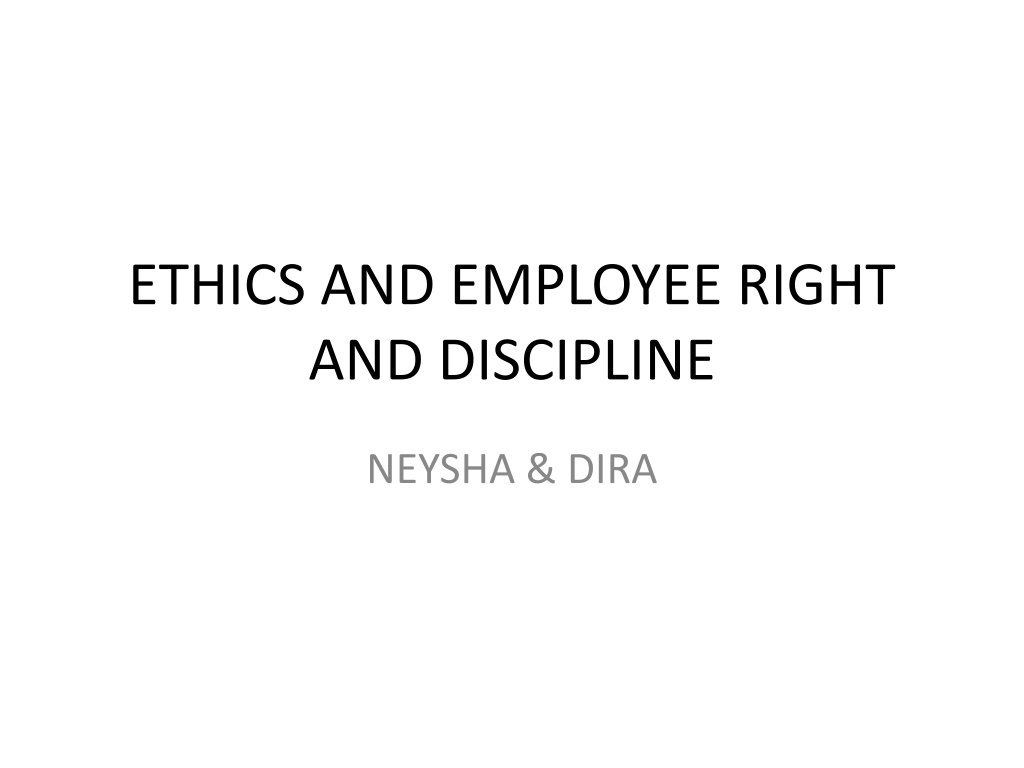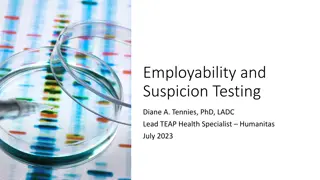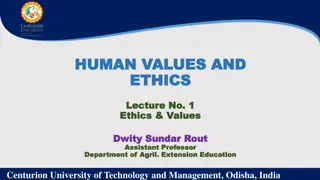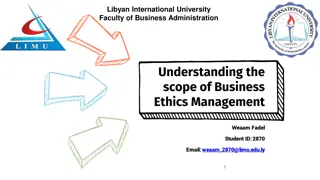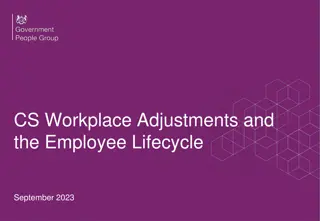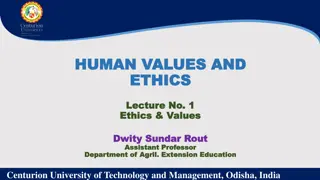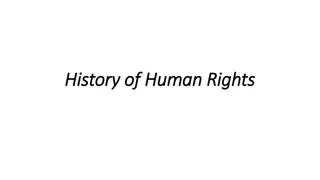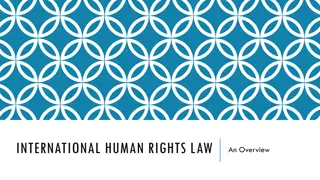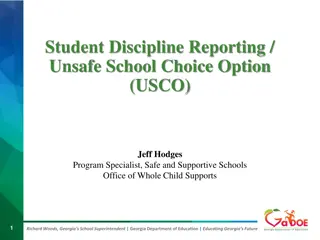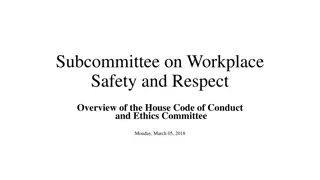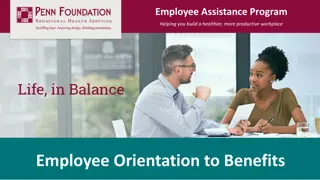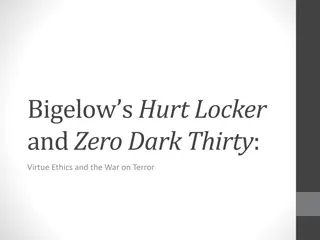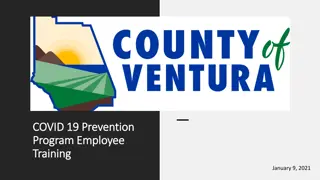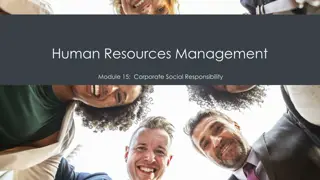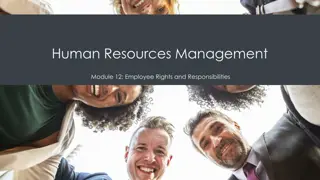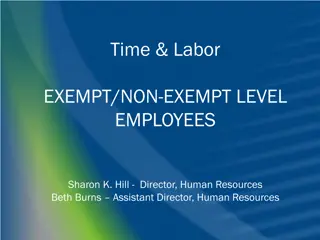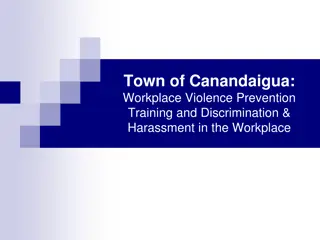Ethics, Employee Rights, and Discipline in the Workplace
Ethics play a crucial role in organizations, guiding individuals and groups on the principles of right and wrong conduct. This includes considering employee rights, disciplinary actions, and the interplay between ethics, law, and fair behavior. Managers can enhance ethical behavior through training, performance appraisals, reward systems, and staff selection. Various factors influence ethical behavior at work, such as individual values, organizational pressures, influence of superiors, legal rules, and organizational culture.
Download Presentation

Please find below an Image/Link to download the presentation.
The content on the website is provided AS IS for your information and personal use only. It may not be sold, licensed, or shared on other websites without obtaining consent from the author. Download presentation by click this link. If you encounter any issues during the download, it is possible that the publisher has removed the file from their server.
E N D
Presentation Transcript
ETHICS AND EMPLOYEE RIGHT AND DISCIPLINE NEYSHA & DIRA
Etika Etika adalah prinsip-prinsip melaksanakan pengaturan terhadap individu atau suatu kelompok; khususnya standar-standar yang anda gunakan untuk memutuskan bagaimana cara anda melaksanakan sesuatu
Etika dan Hukum. Hukum bukanlah hal terbaik dalam hal etika, karena sesuatu bisa saja sah tapi tidak benar, dan sesuatu bisa saja benar tapi tidak sah. Contohnya: Memberikan uang pada pengemis
Etika, Perilaku Adil, dan Hukum. Keadilan adalah bagian yang terintegrasi dari apa yang dipikirkan orang sebagai hukum. Para ahli umumnya mendefinisikan hukum organisasional dalam dua komponen: 1. Hukum distributif mengacu pada keadilan dan dari hasil suatu keputusan. 2. Hukum prosedural mengacu pada keadilan suatu proses yang digunakan oleh perusahaan untuk mengalokasikan kenaikan tunjangan.
Peran MSDM dalam Meningkatkan Etika & Perlakuan Adil Manajer dapat melakukan beberapa hal untuk memastikan bahwa orang lain jugamenilai metode penilaian perusahaan sebagai sesuatu yang adil. Pelatihan. Menunjukkan pada karyawan bagaimana mengenali dilem a etika, bagaimana menggunakan kerangka etika (seperti aturan pelaksanaan) untuk menyelesaikanpermasalahan, bagaimana menggunakan fungsi- fungsi SDM (separti praktik-praktik wawancara pendisplinan) secara etis Performance Appraisal Penilaian menjelaskan bahwa perusahaan tidak hanya mengklaim bahwa mereka percaya dan melakukan standar etika yang tinggi, tapi juga benar- benar mengukur (dan kemudian menghargai) para karyawan yang mengikuti standar Sistem Penghargaan dan Pendisplinan Memastikan bahwa perusahaan menghargai perilaku yang etis dan menghukum perilaku yang tidak etis. Penyusunan Staf dan Seleksi.
FAKTOR YANG MEMBENTUK PERILAKU YANG ETIS SAAT BEKERJA 1. Faktor-Faktor Perorangan Individu membawa nilai-nilai apa yang mereka anggap benar dan salah ke pekerjaan mereka, setiap individu harus menanggung bebankesalahan atas pilihan etika yang dilakukannya. 2. Faktor-Faktor Keorganisasian Berada di bawah tekanan untuk memenuhi jadwal yang penuh tekanan adalah factor pertama yang menyebabkan pelanggaranetika. Oleh karena itu, hampir semua pelanggaranetika terjadi karena para karyawan merasa tertekan untuk melakukan apa yang mereka pikir adalah cara terbaik untuk membantu perusahaan mereka. 3. Pengaruh Atasan Atasan menetapkan karakter umum, tindakannya merupakan sinyal-sinyal tentang apa yang benar dan apa yang salah. 4. Aturan Hukum dan Kebijakan Etika Aturan hukum dan kebijakan etika adalah satu tanda bahwa perusahaan serius dalam masalah etika. 5. Budaya Organisasi Budaya organisasi adalah karakteristik nilai, tradisi, dan perilaku perusahaan yang dimiliki oleh para karyawannya. Budaya perusahaan harus mengirimkan tanda yang jelas tentang apa perilaku yang bisa dan apa yang tidak bisa diterima.
Alasan dari discipline adalah untuk mendorong karyawan untuk berperilaku yang pantas ketika bekerja. Discipline diperlukan ketika seorang karyawan melanggar sebuah peraturan. MANAGING EMPLOYEE DISCIPLINE AND PRIVACY
Fairness in Disciplining Disciplining employees is often unavoidable, but any such discipline must be rooted in the need to be fair. Arbitrators and the courts will consider the fairness of the disciplinary procedures when reviewing disciplinary decisions. Fairness also relates to a wide range of positive employee outcomes. These include enhanced employee commitment and enhanced satisfaction with the organization, and more organizational citizenship behaviors .
Bullying and Victimization Workplace unfairness is often subtle, but can be blatant. Some supervisors are workplace bullies, yelling at or even theatening subordinates. Employess of abusive supervisors are more likely to quit their jobs, and to report lower job and life satisfaction and higher stress. Bullying involves imbalance of power, intent to cause harm, and repetition. Forms of bullying, such as verbal, social, phisical, and cyberbullying.
What Cause Unfair Behavior Supervisors treated pushier employees more fairly: Individuals who communicated assertively were more likely to be treated fairly by the decision maker . Furthermore, supervisors exposed to injustice exhibit abusive behavior against subordinates who they see as vulnerable or provocative. Three supervisory actions influenced perceived fairness: 1. Involving employees in the decisions that affect them by asking for their input and allowing them to refute the others ideas and assumptions; 2. Ensuring that everyone involved and affected understands why final decisions are made and the thinking that underlies the decisions; and 3. Making sure everyone knows up front by what standards you will judge him or her.
Basics of a Fair and Just Disciplinary Process The employer wants its discipline process to be both effective and fair. Employers base such a prcess on three pillars : clear rules and regulations, a system of prgressive penalties, and an appeals process. RULES AND REGULATIONS, such as theft, destruction of company property, drinking on the job, and insubordination. PROGRESSIVE PENALTIES, from oral warnings to written warnings to suspension from the job to discharge.
FORMAL DISCIPLINARY APPEALS PROCESSES, for example FedEx calls its 3-step appeals procedure guaranteed fair treatment: management review, officer complaint, and then executive appeals review. DISCIPLINE WITHOUT PUNISHMENT, aims to avoid the drawbacks of traditional discipline. How it works: 1. Issue an oral reminder, 2. Should another incident arise within 6 weeks, issue a formal written reminder, a copy of which is placed in employee s personnel file, 3. Give a paid, 1-day decision making leave , and 4. If no further incidents occur in the next year or so, purge the 1- day paid suspension from the person s file. But, if behavior reoccurs, typically the next step is dismissal.
Employee monitoring is pervasive. Example, Biometrics using phisical traits such as finger prints or iris scans for Identification. Employers monitor employees electronic activities mostly to improve productivity and to protect themselves from somputer viruses, leaks of confidential information, and harrasment suits. Employee Privacy For most people, invasions of privacy are neither ethical nor fair. The four main types: 1. Intrusion, 2. Publication of private matters, 3. Disclosure of medical record, and 4. Appropriation of an employee s name or likeness for commercial RESTRICTIONS, two main restrictions on workpace monitoring: Electronic Communications Privacy Act (ECPA) and common-law protections against invasion of privacy. Employee Monitoring
Pemberhentian merupakan tahap pendisplinan paling tegas yang employer terapkan. Employer harus memiliki alasan yang cukup untuk memberhentikan karyawan, dan (sesuai peraturan) employer hanya bisa memecat karyawan setelah melewati langkah yang masuk akal untuk merehabilitasikan karyawan. Jalan terbaik untuk meng-handle pemberhentian adalah dengan mencegahnya sejak awal. Banyak kasus pemberhentian dimulai karna keputusan hiring yang buruk. MANAGING DISMISSALS
Termination at Will and Wrongful Discharge Termination at will means that without the contract, either the employer or the employee could terminate at will the employment relationship. WRONGFUL DISCHARGE, refers to a dismissal that violates the law or that fails to comply with contractual arrangements stated or implied by the employer in employee manuals. Three main protections against wrongful discharge are statutory exceptions, common law exceptions, and public policy exceptions.
Grounds for Dismissal INSUBORDINATION, a form of misconduct. Such as direct disregard of the boss s authority, public criticism of the boss, and so on. There are four bases for dismissal: 1. Unsatisfactory performance, 2. Misconduct, 3. Lack of qualifications, and 4. Changed requirements of the job. FAIRNESS IN DISMISSALS, three things to do to make them fair are give the explaination of why and how, institute a formal multistep procedure and a neutral appeal process, and who actuallu does the dismissing. SECURITY MEASURES, using a checklist to ensure that dismissed empoyees return all keys and company property, and accompanying them out of their offices and out of the building.
Avoiding wrongful discharge suits requires a three-pronged approach. 1. Create employment policies, 2. Review and refine all employment- related policies, procedures, and documents to limit challenges, and 3. Make sure you clearly communicate job expectations to employee. Avoiding Wrongful Discharge Suits There are several ways to avoid personal liability. 1. Fully familiar with applicable federal, state, and local statutes, 2. Follow company policies and prcedures, 3. Consistent application of the rule, 4. Does not add to the emotional hardship, 5. Most employee will try to present their side of the story, 6. Do not act in anger, and 7. Utilize the HR department fo advice. Personal Supervisory Liability
The Termination Interview Guidelines for the termination interview; 1. Plan the interview carefully, 2. Get to the point, 3. Describe the situation, 4. Listen, 5. Review all elements of the severance package, and 6. Identify the next step. OUTPLACEMENT COUNSELING, a formal process by which a specialist trains and counsels a terminated person in the techniques of self-appraisal and securing a new position. EXIT INTERVIEW, usually conducted by HR professional just prior to the employee leaving.
Layoffs, Downsizing, and the Plant Closing Law PREPARING FOR LAYOFFS, need to make sure appraisals are up-to-date, identify top performers and get them working on the company s future, and have leaders committed to the company s turnaround. Layoff occur when workers go home for a time due to lack of work (usually not permanent). Downsizing occur when employer reducing number of people employed. DISMISSAL S EFFECT, often result in harmful psychological and physical health for employees who lose their job. THE PLANT CLOSING LAW, requires employers of 100 or more employess to give 60 days notice before closing a facility or starting a layoff of 50 people or more. BUMPING/LAYOFF PROCEDURE, has three conditions usually present are there is no work available for these employees, management expects the no-work situation to be temporary and probably short-term, and management intends to recall the employees when work is again available. THE LAYOFF PROCESS, including identify objectives and constraints, form a downsizing team, address legal issues, plan post-implementation actions, address security concern, and try to remain informative. LAYOFF AND DOWNSIZING ALTERNATIVE, one suggestions include finding volunteers who are interested in reducing hours or part- timme work, using attrition, and even networking with local employers concerning temporary or permanent redeployments.
Adjusting to Downsizing and Mergers O ptions here include cut cost without reducing the workforce, introduce a hiring freeze before reducing the workforce, provide candid communications about the need for the downsizing, give employees an opportunity to express their opinions about the downsizing, and be fair and compassionate in implementing the downsizing. M E R G E R G U ID E L IN E , manager s behoove to treat employee fairly: avoid the appearance of power and domination, avoid win-lose behavior, remain businesslike and professional in all dealing, maintain as positive a feeling about the acquired company as possible, and remember that the degree to which your organization treats the acquired group with care and dignity will affect the confidence, productivity, and commitment of those who remain.
